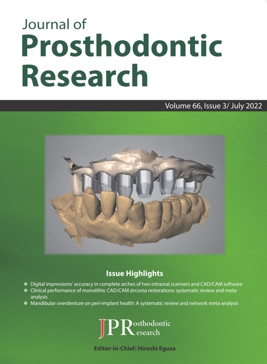66 巻, 3 号
選択された号の論文の24件中1~24を表示しています
- |<
- <
- 1
- >
- >|
Editorial
-
原稿種別: Editorial
2022 年 66 巻 3 号 p. vi-vii
発行日: 2022年
公開日: 2022/07/30
PDF形式でダウンロード (144K)
Guest Editorial
-
原稿種別: Guest Editorial
2022 年 66 巻 3 号 p. viii-xi
発行日: 2022年
公開日: 2022/07/30
PDF形式でダウンロード (349K)
Review article
-
原稿種別: Review article
2022 年 66 巻 3 号 p. 357-373
発行日: 2022年
公開日: 2022/07/30
[早期公開] 公開日: 2021/09/30PDF形式でダウンロード (1421K) -
原稿種別: Review article
2022 年 66 巻 3 号 p. 374-384
発行日: 2022年
公開日: 2022/07/30
[早期公開] 公開日: 2021/10/06PDF形式でダウンロード (632K) -
原稿種別: Review article
2022 年 66 巻 3 号 p. 385-394
発行日: 2022年
公開日: 2022/07/30
[早期公開] 公開日: 2021/12/01PDF形式でダウンロード (558K) -
原稿種別: Review article
2022 年 66 巻 3 号 p. 395-401
発行日: 2022年
公開日: 2022/07/30
[早期公開] 公開日: 2022/03/11PDF形式でダウンロード (279K)
Original article
-
原稿種別: Original article
2022 年 66 巻 3 号 p. 402-408
発行日: 2022年
公開日: 2022/07/30
[早期公開] 公開日: 2021/09/25PDF形式でダウンロード (609K) -
原稿種別: Original article
2022 年 66 巻 3 号 p. 409-415
発行日: 2022年
公開日: 2022/07/30
[早期公開] 公開日: 2021/11/18PDF形式でダウンロード (483K) -
原稿種別: Original article
2022 年 66 巻 3 号 p. 416-421
発行日: 2022年
公開日: 2022/07/30
[早期公開] 公開日: 2021/11/18PDF形式でダウンロード (344K) -
原稿種別: Original article
2022 年 66 巻 3 号 p. 422-430
発行日: 2022年
公開日: 2022/07/30
[早期公開] 公開日: 2021/09/18PDF形式でダウンロード (876K) -
原稿種別: Original article
2022 年 66 巻 3 号 p. 431-437
発行日: 2022年
公開日: 2022/07/30
[早期公開] 公開日: 2021/10/15PDF形式でダウンロード (609K) -
原稿種別: Original article
2022 年 66 巻 3 号 p. 438-444
発行日: 2022年
公開日: 2022/07/30
[早期公開] 公開日: 2021/09/30PDF形式でダウンロード (478K) -
原稿種別: Original article
2022 年 66 巻 3 号 p. 445-451
発行日: 2022年
公開日: 2022/07/30
[早期公開] 公開日: 2021/09/28PDF形式でダウンロード (445K) -
原稿種別: Original article
2022 年 66 巻 3 号 p. 452-458
発行日: 2022年
公開日: 2022/07/30
[早期公開] 公開日: 2021/10/14PDF形式でダウンロード (393K) -
原稿種別: Original article
2022 年 66 巻 3 号 p. 459-465
発行日: 2022年
公開日: 2022/07/30
[早期公開] 公開日: 2021/10/06PDF形式でダウンロード (815K) -
原稿種別: Original article
2022 年 66 巻 3 号 p. 466-475
発行日: 2022年
公開日: 2022/07/30
[早期公開] 公開日: 2021/12/02PDF形式でダウンロード (1612K) -
原稿種別: Original article
2022 年 66 巻 3 号 p. 476-483
発行日: 2022年
公開日: 2022/07/30
[早期公開] 公開日: 2021/12/06PDF形式でダウンロード (731K) -
原稿種別: Original article
2022 年 66 巻 3 号 p. 484-490
発行日: 2022年
公開日: 2022/07/30
[早期公開] 公開日: 2021/11/30PDF形式でダウンロード (316K) -
原稿種別: Original article
2022 年 66 巻 3 号 p. 491-501
発行日: 2022年
公開日: 2022/07/30
[早期公開] 公開日: 2021/11/30PDF形式でダウンロード (1854K) -
原稿種別: Original article
2022 年 66 巻 3 号 p. 502-508
発行日: 2022年
公開日: 2022/07/30
[早期公開] 公開日: 2021/12/01PDF形式でダウンロード (961K)
Technical procedure
-
原稿種別: Technical procedure
2022 年 66 巻 3 号 p. 509-513
発行日: 2022年
公開日: 2022/07/30
[早期公開] 公開日: 2021/11/18PDF形式でダウンロード (509K)
Case report
-
原稿種別: Case report
2022 年 66 巻 3 号 p. 514-518
発行日: 2022年
公開日: 2022/07/30
[早期公開] 公開日: 2021/10/14PDF形式でダウンロード (454K) -
原稿種別: Case report
2022 年 66 巻 3 号 p. 519-523
発行日: 2022年
公開日: 2022/07/30
[早期公開] 公開日: 2021/11/30PDF形式でダウンロード (627K)
News
-
原稿種別: News
2022 年 66 巻 3 号 論文ID: JPR_66_3_nw
発行日: 2022年
公開日: 2022/07/30
PDF形式でダウンロード (185K)
- |<
- <
- 1
- >
- >|
